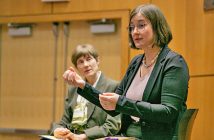Fordham’s Graduate School of Religion and Religious Education (GRE) deepened the growing dialogue surrounding lay ministry in the Catholic Church on Sept. 25, hosting its third conference on a landmark document, Co-Workers in the Vineyard of the Lord.

Michael Horan, Ph.D.

Zeni Fox, Ph.D. (photos by Janet Sassi)
The document is the Conference of Catholic Bishops’ 2005 response to the rise in lay ecclesial ministers, or LEMs, accompanying the decline in church clergy. According to the National Catholic Reporter, by 2010 the active diocesan clergy in the United States will be less than the number of parishes, leaving lay ministers to fill the gap.
“Lay ecclesial ministry is the most significant thing to have happened in the Catholic Church in the last 1,000 years,” Anthony Ciorra, Ph.D., dean of GRE, told 200 scholars, clergy and parish professionals gathered on the Rose Hill campus. “It is the thing that dropped out of nowhere—nobody planned it, the bishops didn’t approve it. We woke up one day and realized we had 30,000 lay persons involved in ministry in the United States.”
Michael Horan, Ph.D., professor of religious education and pastoral theology at Loyola Marymount University, described LEMs as “living parables.” Lay ecclesial ministers are non-ordained—and often volunteer—pastoral ministers who have answered their calling to do evangelical missionary work, teaching and other grassroots ministry alongside priests, deacons and theologians.
“These leaders defy the usual categories for holiness and leadership, formerly requiring celibacy and ordination,” Horan said. “But will these lay professional ministers be accepted as credible by the people they seek to serve? Will they be regarded by clergy as peers or underlings, as co-workers or as migrant workers temporarily available for lots of work and easily sent on their way?”
Although the Co-Workers’ document offers “theological vision” in recognizing a growing lay ministry, Zeni Fox, Ph.D., professor of pastoral theology at Immaculate Conception Seminary, said it does not adequately address the question of who is a LEM.
Fox, who served as an adviser to the bishops’ subcommittee on lay ministry as it developed Co-Workers, said that the bishops in each diocese decide who, and who is not, a LEM. Therefore, there is widespread confusion and no official “vocation” for a LEM, leading to problems of adequate training, pay, hierarchal placement and performance management.
“Many of these men and women have not been so designated by their bishop,” said Fox. “We have a firm number of priests and permanent deacons. We have a firm number of sisters, a firm number brothers—but there is no firm number of LEMS. It’s all very fuzzy.”
Fox cited a recent Emerging Models of Pastoral Leadership Project, funded by the Lilly Endowment, which has identified areas for improvement. They include:
• Developing comprehensive training programs and materials for ministering in a multiple-parish environment.
• Including lay leaders in decisions on merging and closing parishes;
• Defining clearly and precisely the roles, responsibilities and relationships of LEMs;
• Making it a vocation, providing ongoing skill development and creating accountability through performance reviews for both ordained and lay clergy.
Fox said she was distressed by those in the church who see the idea of “collaboration” among clergy and lay ministers as a threat. Father Ciorra suggested that church leaders consider a model of collaboration by looking toward the model that exists in God’s trinity, where “no one spirit dominates the icon.”
“We are about three steps behind where the Holy Spirit has gone,” Ciorra concluded. “The very notion of collaboration is what God does.”


